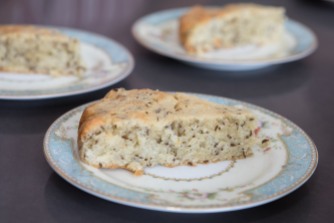This recreation of a Seed Cake recipe was both inspired and informed by my participation in conversations about Robert Forbes’s manuscript The Lyon in Mourning in Edinburgh in 2022 and beyond. Learn more about the project here: https://dhil.lib.sfu.ca/lyoninmourning/
Charles Edward Stuart eats oat porridge, bread and butter, and cake in various episodes documented in Robert Forbes’s encyclopedic and commemorative manuscript, The Lyon in Mourning. But Forbes did not only describe scenes of eating. He also collected and transcribed the documents relating to provisioning the household: “Copy (exact & faithful) of the Accompts of James Gib, who served the Prince in Station of Master-houshold & Provisor for the Prince’s own Table.”
Gib’s detailed accounts are valuable to food historians as they provide insight into eighteenth-century food culture as well as the practical constraints of maintaining an elite household on the move. Moreover, Forbes’s choice to include these quotidian accounts of household management in his manuscript alongside poems, songs, conversations, and letters speaks to the comprehensive nature of his project: Food, the stuff of everyday life, was just as important to document as any other detail of the final Jacobite rising.
Among payments for butter, eggs, poultry, wine, ale, brandy, lemons, spices, salt, oat bread, fruit, and fish, “seed cake” is listed twice in Gib’s accounts – December 22, 1745 and January 25, 1746. It is the only kind of cake listed in the accounts and it was likely purchased from local bakers. Seed cake was immediately familiar to me and I’ve enjoyed preparing seed cakes in the past. Prepared at the harvest and flavored with locally grown caraway seeds, seed cake is a precursor to the modern British cakes that are typically served at teatime.
Although we now associate caraway seeds with savory dishes, caraway was cultivated widely in northern Europe and caraway seeds were widely used in sweets in British cookery in the sixteenth, seventeenth, and eighteenth centuries. A simple seed cake recipe might call for flour, butter, eggs, and the crucial caraway seeds. The cake would be leavened with either vigorously whisked eggs or ale barm – fresh yeast scooped from the top of a vat of beer.
The recipe that I have recreated below is from an eighteenth-century cookery manuscript that, like the Lyon in Mourning, is held at the National Library of Scotland: MS24775 “Pastry Book Elgin 20th August 1734.” It is leavened with whipped eggs and is slightly fancier than the typical seed cake. This recipe calls for the addition of candied citrus peel – candied orange or candied citron – as well as sliced almonds. Whereas caraway seeds were grown locally, citrus and almonds were imported to the British isles from southern Europe. This cake has a chewy, meringue-like texture as a result of the fluffy eggs that give it its rise. The vegetal flavor of the caraway seeds is nicely balanced by the tangy sweetness of citrus from the candied peel and the rich nutty crunch of almond slivers.
Original Recipe
31.
To Make Seed-Cake
Take a pound of sugar being beat &
searched & nine Eggs keeping back Two of
the Yolks Cast them with Sugar till they
be white – Then Steer in a pound of flour
four Ounces of Citron & Orange peel four
ounces of Cutt almonds & two ounces of seeds.
being mixed altogether put your Cake in
a frame & bake it – You may do a plumb
Cake after the same manner only
only adding Two pounds of Curranes
& to Each pound of sugar six ounce
Of beat Butter & four drop of Cloves
Updated Recipe
1 ¾ cups flour (225g)
¾ cup candied citrus peel – orange, citron, or a combination of the two (55g)
½ cup sliced almonds (55g)
2 Tablespoons and 2 teaspoons caraway seeds
5 eggs (3 whole, 2 whites)
1 cup sugar (225g)
Preheat your oven to 350°F. Grease a 9-inch springform pan and line with parchment.
Stir together flour, candied citrus peel, sliced almonds, and caraway seeds. The citrus pieces should be nicely coated with flour. Set aside.
Separate two eggs and put the two whites in a large bowl. Add the additional three whole eggs. Using a mixer, whisk the eggs for approximately 2 minutes until they become very fluffy. Add the sugar. Whisk on a high speed for approximately 5 minutes until the mixture is glossy and visible bubbles have formed.
Fold the flour mixture into the egg mixture using a spatula. Stir and fold gently until there are no visible clumps of flour.
Pour the batter into your prepared pan. Place it on a baking sheet in the middle of the oven.
Bake for 40 minutes until golden and set in the middle. A cake tester will come out clean when it is completely cooked.
Allow the seed cake to cool for at least 10 minutes before removing it from the springform pan.


























You must be logged in to post a comment.